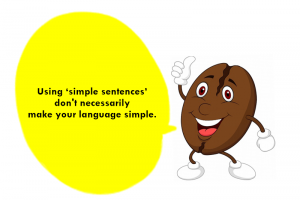In your childhood, how often have you heard your parents or teachers telling you (sometimes yelling at you) with their raised eyebrows: “MIND YOUR LANGUAGE”? Quite honestly, I have heard it hundreds of time; I am sure you too have. Even today, although our educational system and learning practices have undergone massive changes, “mind your language” is one of the favourite catch phrases of teachers and parents alike.
Now, imagine a scenario where a group of young learners tell their instructors to mind their language. That surely sounds impolite and scandalous, doesn’t that? Well, not really, I would say; especially when we consider the important role language plays in both instruction and learning. Yes, we are talking about the language used in instructional settings and the language in which learning materials are developed.

What do young e-Learners hate the most?
That is difficult to answer, isn’t that? There could be plenty of things, from the colour of images and the size of the font used to the length of learning sessions and questions used for assessment. One learner may like what another learner hates.
Let me tell you a secret about young learners. They all hate one thing ubiquitously and consistently – unintelligible language. No learner wants to sit in a classroom, be it real or virtual, and spend their energy on making sense of what is written or spoken about in their learning materials.
Is language your top priority?
The importance of language in e-Learning content cannot be dismissed for it is central to the cognitive process called learning. However, the quality and appropriateness of language remain the last in the priority list of many e-Learning content developers and companies, especially with the advent of rapid authoring tools.
As a corollary, of the thousands of e-Learning courses being launched every month, only a few achieve their desired goals. There are millions of young learners out there who wish, knowingly or unknowingly, that those who develop learning materials did mind their language.
[pullquote]Though language wouldn’t win the battle for you single-handedly, it alone is capable of becoming your Waterloo.[/pullquote]It is truly unfortunate that language is not given the priority or credit it deserves. What is more unfortunate is the tendency of people to reduce language to mere “style” or “grammar”. I have heard people asking “What’s the big deal about language. It is just a matter of proofreading once the content is developed”.
My dear comrade, let me tell you something without even stepping into any of the deeper, denser or philosophical questions about language – the language you use can make or break not just your content, but your e-learning course as well. So it is high time you kiss goodbye your what-is-the-big-deal-about-language mindset and start minding your language.
Why is language important in e-Learning content?
The answer is pretty simple and straightforward. An e-Learning course or module can get only as good as its content; and the success or failure of content is determined to a large extent by the language you use.
It contributes to the effectiveness of your course: As against a traditional instructional setting, in an e-Learning scenario learners are left with huge amounts of content. In a typical e-Learning module, textual content forms more than 50% and up to 80% of the whole content. It, therefore, is no exaggeration that the effectiveness of an e-Learning course is determined by the language used.
It determines the level of engagement: If there is no engagement from learners, an e-Learning course falls flat. The content you present and how you present it both impacts the level of engagement to a considerable degree.
It ensures proper assessment: In the assessment session, you basically assess the entry behavior and the exit behavior of the learner to measure the effectiveness of learning and instruction. How can you assess this if your young learners were doing nothing but trying to understand your words, phrases and sentences, from the moment they “entered” till they “exited”?
It makes small screen learning a success: I am yet to meet someone who offered a successful e-Learning course just by transferring the contents of textbooks to electronic platforms. When learning happens through small screens, be it with the assistance of teachers or not, you should pay extra care to how you use language to drive ideas home.
The cardinal language rules for developing e-Learning content
 This brings us to the most important question– how to use language while developing e-Learning content for school kids. You may be a teacher who plans to develop an e-Learning module for your students; or a company that provides e-Learning or m-Learning solutions to educational institutions; or a professional content developer specialized in instructional content.
This brings us to the most important question– how to use language while developing e-Learning content for school kids. You may be a teacher who plans to develop an e-Learning module for your students; or a company that provides e-Learning or m-Learning solutions to educational institutions; or a professional content developer specialized in instructional content.
Whoever you are, there are certain guidelines you should abide by. We call it the cardinal rules of language; and there are seven of them. In a series of posts that follows, titled “Developing E-Learning Content for School Kids? Mind Your Language”, we are making a humble attempt to touch upon some of the crucial aspects of language an instructional content designer should keep in mind.
Here is the first rule: Developing E-Learning Content for School Kids? Mind Your Language- PART 1
A final word before we begin
That said, your e-Learning initiative will not succeed solely by following these language rules; there indeed are other contributing factors, for instance, clear instructional objectives, proper assemblage of content, appropriate assessment tools, navigability, and so on. Though language wouldn’t win the battle for you single-handedly, it alone is capable of becoming your Waterloo.






